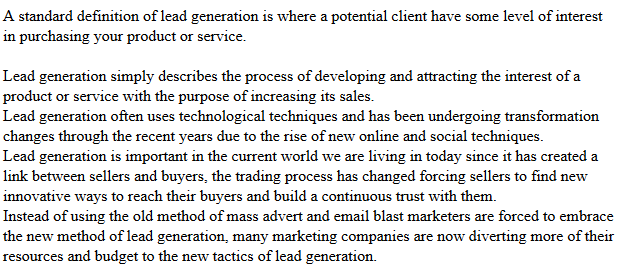We didn’t want to outsource the content job. Our plans were ambitious, and we needed more skilled writers to leverage our content marketing efforts.
The process of recruiting staff was too long for that, so we decided to go with freelancers.
Lesson 1: Cheap Copywriters Are Too Busy to Be Good

source: depositphotos.com
We were lured (as many of us) by the eagerness of many freelance copywriters to create the quality content at a low price. Despite our skepticism, we wondered if we could make it work.
For a start, we determined it to be the 800-word paid test assignment. Five writers from different writing services received clear styling guidelines from us and got hired.
When we checked the content these freelancers submitted, we became upset.
Consider this particular piece of content on the topic titled “Quantity Is the King in B2B Lead Generation.”

A typical writing style of cheap freelance copywriters
Let me tell you what is wrong with it.
- The writing has nothing to do with the topic aimed at assigning a high priority to the volume of marketing activities in the B2B lead generation.
- The writing is superficial and provides no value to readers.
Our biggest mistake was to believe that copywriters would do the research and come up with facts, supporting evidence and useful tips on their own.
Our expectations didn’t correlate with the reality in which cheap content writers take as many clients as they can to compensate their low rates with the volume of work. They usually have a vague idea about the domain of knowledge the topic belongs to and aren’t motivated to explore it.
More to that, cheap copywriters are unaware of what a proper research is and are prone to rewrite first two or three relevant links they find in Google search.
We figured out that our approach to cooperation with low-cost content writers was deficient and made our minds to change duties and responsibilities.
Lesson 2: Do Not Even Try to Teach Cheap Copywriters New Things

source: depositphotos.com
Rules of the game were different this time. We decided to do the research in-house and outsource only the writing part.
By that time, we have already established the process of searching facts, statistics and other data to make blog posts look credible.
It didn’t make sense to ask copywriters to follow the guide, so I took charge of the research all by myself.
This was my scenario:
- I come up with the article topic and the headline.
- I specify the purpose of the article, the target reader, best article examples and styling guidelines for copywriters.
- I prepare the outline with facts, so copywriters won’t need to research anything.
- A copywriter checks the facts from the outline and uses them in the article with attribution to their author and the source. He or she submits the draft for me to review.
- We go through two-three rounds of edits, and at the end, I get what I want.
I clearly stated that copywriter’s job would be to read the outline details, make sense of them and weave the core points into the canvas of their text explained in their own words.
I took responsibility for the digging, and I expected copywriters to do the presenting, (i.e. creating a coherent story based on my findings).
My only concern was that it would be difficult for content writers to take someone else facts and make a meaningful story out of them.
I didn’t hope to get much from cheap copywriters. My ultimate goal was to check if it’s possible to organize the content writing process in a way for one individual to collect the facts and for the other to create a coherent text using information provided.
I chose a complicated topic from the start to test the process
I needed to know how the content writers will make sense of a complicated issue. The title was, “Why SaaS Companies Prefer Agile Marketing Approach” (in the meantime, our team was working on a 4500-word step-by-step long read, called, SaaS Marketing Plan: The Ultimate Guide How to Build It).
I prepared the outline for the article, did the research and collected facts.
The creative part of my job was over. Management hustle began when I placed the job offer with the intent to hire two different copywriters.
After a few hours of communication with candidates, I selected the one from Bangladesh and the other from the Ukraine.
Later I found out both are content agencies.
They checked the guidelines and the outline and both agreed to use them.
I explicitly told my contractors it was a paid test assignment and I have more work for them if they follow the requirements.
This was my outline.

My outline for copywriters
Freelancers could check facts by hovering the mouse over clickable notes.

Facts and sources I collected for copywriters
The Ukrainian copywriter submitted the article one day before the deadline. It was a great start, but the article had nothing to do with the outline. It contained NO SINGLE FACT and no attribution to sources I asked to use.
After I had sent him my angry feedback, he apologized and delivered the second version of the article within a day.
This new version wasn’t written according to the outline either! It was a rewrite of some random article popping up in Google top on the “how to implement agile marketing” search query.
The guy was able to deliver the outline-based article only on the THIRD attempt.
The problem was that the facts mentioned in the article didn’t constitute a story. They were all messy and incoherent.
I refused to continue sick communication, released the payment and ended the contract.
The Bangladeshi contractor didn’t neglect the outline. He mentioned all my facts in the article, but between them, words and phrases were meaningless and resembled the talk about nothing. Besides, his intro was a rewrite of the first article in Google search dedicated to “SaaS marketing.”
I realized 20 rounds of edits should be done before the article looks credible. It would be a massive investment of time, so I made a payment and dismissed this copywriter as well.
Lesson 3: Writing Guidelines Won’t Help. You Have to Change the System First

source: depositphotos.com
The main thing is NOT in how you manage cheap outsourced writers. Unfortunately, your attitudes, behavior and clear-cut guidelines won’t make a big difference.
It’s the whole freelance writing system that is flawed and has to be changed before you will be able to get high-quality articles on a regular basis.
To realize the drawbacks of this system, let’s look at it from the perspective of a sociologist Kurt Lewin.
According to Kurt’s vision, the progress in moving towards the goal is directed by driving and restraining forces. When driving forces are stronger, our speed is high, and we accomplish what we want quickly. Restraining forces antagonize the progress. They are resisting the motion and slowing it down.
In the case of the cheap content writers, the only driving force leading to the production of high-quality articles was my wish and my management discipline.
As opposed to that, restraining forces were more powerful and numerous.
Look at them.
- Cheap copywriters care about quantity, not quality. Their low rates can only be balanced by the volume of work they take. In other words, the more clients they serve in a shorter period, the more money they earn. Now you realize how motivated such copywriters are to spend hours on the research and subsequent rounds of edits.
- Niche topics such as SaaS marketing require proficiency in both SaaS and marketing. Usually, low-cost copywriters have expertise in neither of them and approach the complex subject the same way they write about lipstick brands.
- Many content agencies with low rates reach profitability through passing the writing to someone else with even lower hourly rates. Think of the content quality level these super cheap junior copywriters can deliver.
- Some clients who approach freelance writers don’t need high-class content. They are looking for SEO text to make their websites appear relevant in the eyes of Google. No one will share such content or read it from the beginning to the end, except for search engine crawler (hint: Google doesn’t appreciate websites with second-rate content either). Anyways, no copywriter will break the habit of writing low-grade content if there’s demand for it.
Now I see why my undertaking was doomed from the start. Restraining forces of the system way exceeded driving motives.
How To Move On with Content Writers?
I do not discourage anyone from hiring cheap content writers. If you have enough time, you can go over my plan of doing the research in-house and outsourcing the writing part. Alternatively, you can come up with something different and cut your teeth.
Also, if your content quality demands are not high, cheap copywriters may be of real help.
However, if your article standards are high, your industry is too niche, or you are looking for research-backed content, don’t work with freelancers willing to write a 2,000-word blog post for a couple of bucks.
It’s very likely you will spend money for nothing and get disappointed.
The more sophisticated the industry is (consider the development of encryption software, for example), the more you have to pay for a well-researched piece of content. Remember, that niche expertise and research skills are difficult to find, so they can’t be cheap.
Another option will be to hire writers and train them in-house to cover your content needs. Even though it’s not the most affordable solution either, your investment of money and time will pay off.
Have you tried hiring cheap content freelancers? Were you satisfied with what you got? Let me know in comments!
